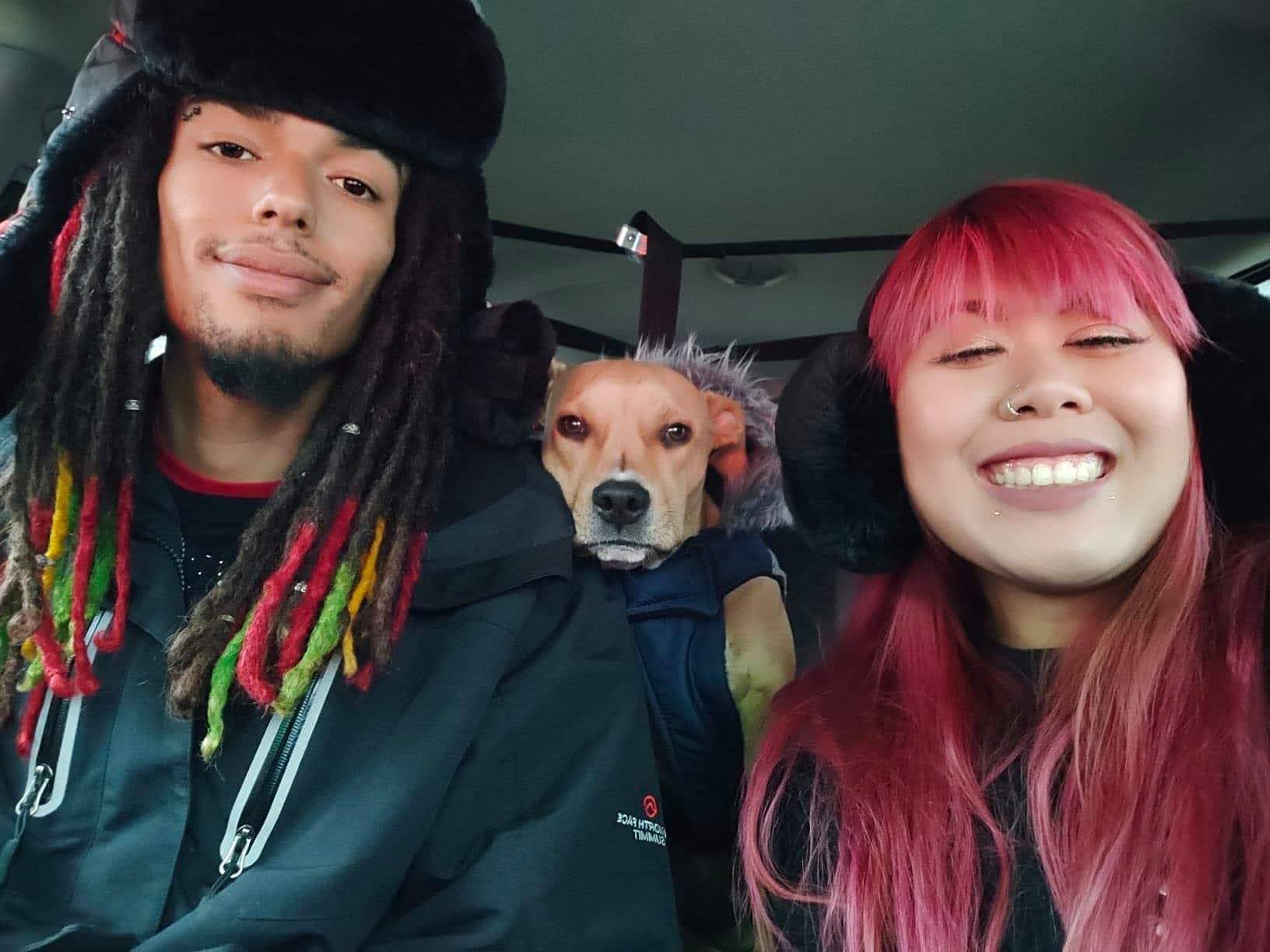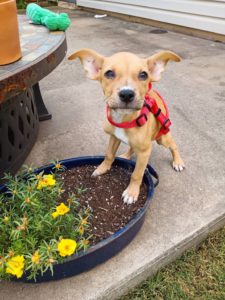
Kasey and Jeannif Robinson were not looking to adopt a dog when they came across a Pitbull mix puppy at the flea market in Oklahoma City near their hometown of Choctaw, Oklahoma.
“I wasn’t looking for a dog at all,” Kasey said. “But I saw him and I felt so bad. I thought, ‘if we don’t save this dog he’s going to die.’”
The puppy was not in good shape; his ribs were visible through his skin, and the Robinsons were afraid to pick him up because he looked so frail. Despite weighing only seven pounds at six weeks old, his friendly and playful temperament shined through. Kasey and Jeannif decided to name him Ivar after a character in one of their favorite television shows, Vikings.
“Ivar is one of the Viking characters, who was born a cripple and became a king,” Kasey said. “Even when our Ivar was skin and bones, he was a feisty little thing. We knew he would be a survivor.”

The Robinsons took Ivar home and got him in to see a veterinarian, and found out he had hookworm, mites, and a heart murmur. The vet explained that Ivar may grow out of the heart murmur around six months of age. But, when his six-month birthday came around, the Robinsons could tell there was still something wrong with his heart.
“We could feel it. He didn’t have a pulse; it was more of a vibration in his chest,” Kasey said.
Their veterinarian performed an echocardiogram and captured an ultrasound image of Ivar’s heart, and found he had a large hole between the lower chambers of his heart. Based on the size of the hole, the Robinsons had two choices: do nothing, knowing Ivar had a high chance of experiencing heart failure in the future, or pursue open heart surgery to close to hole.
For Kasey and Jeannif, doing nothing was not an option. However, not only was open heart surgery more expensive, it also was a more invasive ordeal than they wanted for Ivar. They had to find a veterinary cardiologist who could perform the surgery, ideally minimally invasively and with a lower price tag. With the help of their primary care veterinarian, Dr. Hodgson, they searched across the country for a cardiologist who would take Ivar’s case. After a nearly two-month search, they found the Colorado State University Veterinary Teaching Hospital.
Finding the perfect fit
“They reached out to me about whether or not we could do something,” said Dr. Brian Scansen, head of the cardiology service at the hospital. “We felt we might be able to but needed an understanding of Ivar’s exact anatomy.”
Ivar and his owners made the trip out to Fort Collins for a cardiac ultrasound and CT scan to get a better view of the hole. Using the detailed, three-dimensional imaging capabilities of the hospital’s CT scanner, Scansen wanted to ensure he selected a device that would fit into the hole in Ivar’s heart safely, without impinging on any surrounding valves. To make doubly sure, he recruited the hospital’s oncology service to print a 3D model of Ivar’s heart.
Dr. Del Leary, a medical physicist in the hospital’s oncology service, runs a physics lab which houses machines for radiation treatment for animal patients – including several 3D printers. Dr. Bernard Chi, a graduate student with Scansen specializing in cardiac CT, segmented the scan and prepared the images for printing. When Chi reached out on a Thursday to see if Leary could have a model of Ivar’s heart printed by the following Monday, he and his radiation oncology veterinary technician, Amber Prebble, didn’t hesitate to lend their expertise.
“The heart had to be printed in two halves so they could access the inside of it, and so the 3D printer could handle it – it takes roughly 24 hours per side to complete,” Prebble said. “I was able to print one section by Friday afternoon, I came in on Saturday to print the other, and then came in early on Monday to do all the post processing.”

“Amber is the hero in terms of going beyond the call of duty to come after hours to make this happen,” Leary said. “There was a limited time window for this to work.”
When Scansen received the model, he was able to test the catheter and device he wanted to insert into Ivar’s heart and ensure it fit before performing the actual surgery. Based on the 3D print, the device looked like it would fit safely, and just as importantly, would close the hole.
“Being able to actually test the device in Ivar’s specific anatomy was a big advancement,” Scansen said. “Rather than guessing what might work, we can understand patient-specific anatomy in very fine detail and be able to choose a precise device for their individual needs.”
Individualized medicine, rather than a population-based approach, continues to grow in popularity in the human medical world, and Scansen hopes to adopt a similar approach for animal patients, too.
After practicing the procedure on the 3D model, Scansen and his team successfully closed the hole in Ivar’s heart in the Pocket Foundation Hybrid Cardiac Interventional Suite, guided by the CT and with advanced ultrasound – and the catheter fit just as it did in the 3D print, allowing Ivar to be discharged the next day.
Road to recovery

With a successful surgery completed, Kasey and Jeannif are relieved for their pup, but Ivar still has a few weeks of recovery ahead of him before he can lead a normal doggie life. Because Ivar is under 24/7 watch to ensure healthy scar tissue develops over the device to hold it in place, Kasey recruited the help of his mom, Gayla, to keep eyes on Ivar around the clock.
“We have to make sure the device doesn’t dislodge, like if he’s jumping up and down,” Kasey said. “We knew this would be easier on him than with open heart surgery, and between the three of us, we can manage.”
Just like he and his family managed the demanding recovery schedule, there was never a doubt in Kasey’s mind that Ivar would have his surgery in the first place – despite the cost. Though the minimally invasive approach was much less expensive than open heart surgery, Kasey and Jeannif paid for the procedure with credit cards and started a gofundme page to help alleviate the financial burden.
Ivar will return to the Veterinary Teaching Hospital in April for a post-operative scan, and in the meantime, he’s living up to his namesake.
“Before we got his initial scan he was really active, so we’re just trying to keep him calm then slowly work him back into his old habits,” Kasey said. “The second day after surgery he was already ready to play.”